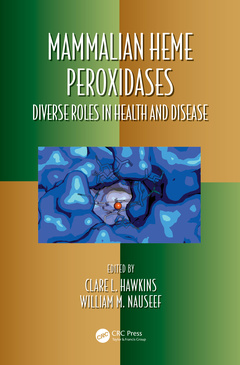Mammalian Heme Peroxidases Diverse Roles in Health and Disease Oxidative Stress and Disease Series
Coordonnateurs : Hawkins Clare, Nauseef William M

Mammalian heme peroxidase enzymes play a critical role in innate immune responses and disease prevention. The formation of potent chemical oxidants is essential to this protective physiologic activity in immunity. Although highly beneficial in the context of immune defense, it is now well established that peroxidases and their overproduction of oxidants contribute to the initiation and persistence of many chronic inflammatory conditions in the cardiovascular, neurologic, respiratory, renal, and gastrointestinal systems. Peroxidasins, a protein family related to heme peroxidases, play a novel role in tissue biogenesis and matrix assembly, which are also attracting attention in different pathological contexts. Given the diverse roles of mammalian heme peroxidases and the breadth and incidence of pathologies associated with these enzymes, there has been significant interest in modulating peroxidase activity as a therapeutic strategy. This book highlights recent developments in our understanding of the chemistry, biochemistry and biological roles of mammalian peroxidases and their associated oxidants, their involvement in both innate immunity and chronic inflammatory disease in a variety of end organs, and potential therapeutic approaches to modulate and prevent damaging reactions.
Key Features
- Structure and biosynthesis of mammalian peroxidases
- Reactivity of hypohalous acids with biological substrates
- Peroxidases in innate immunity
- Peroxidases in human pathology
- Modulation of peroxidase-induced biological damage
SECTION 1: INTRODUCTION TO MAMMALIAN HEME PEROXIDASES
Structure, function, phylogeny of heme peroxidases
Biosynthesis of MPO and other heme peroxidases
Peroxidasin structure and function
SECTION 2: REACTIVITY OF PEROXIDASE OXIDANTS
Reactivity of peroxidase oxidants with proteins and proteoglycans
Reactivity of peroxidase with nucleic acids, RNA and DNA
Reactivity of peroxidase oxidants with lipids – modification and signaling
Role of MPO in the modification of lipoproteins (LDL and HDL)
Regulation of cellular signaling and survival by peroxidase oxidants
Global profiling of cell responses to peroxidase oxidants
SECTION 3: PEROXIDASES IN INNATE IMMUNITY
MPO and immune cell recruitment and activation
Role of MPO in extracellular trap release by neutrophils
Imaging HOCl production by neutrophils
How microbes combat reactive chlorine species
Priming the innate immune system to combat respiratory disease
SECTION 4: PEROXIDASES IN PATHOLOGY
Imaging the reactivity of MPO in vivo
Role of MPO in vascular dysfunction and signaling
MPO in ischemic heart disease
Role of MPO in neurodegenerative disease
Role of MPO in kidney disease
Role of peroxidases in respiratory disease
Role of peroxidasins in disease
SECTION 5: PREVENTION OF MPO INDUCED DAMAGE
Design and functionality of MPO inhibitors
Modulation of disease using MPO inhibitors
Novel peroxidase inhibitory protein “SPIN” with broad target specificity
Selenium and resistance to oxidative enzyme inactivation
Clare Hawkins is a Professor in the Department of Biomedical Sciences, University of Copenhagen. She appointed in March 2017 after nearly 20 years in Sydney at the Heart Research Institute, where she held the position of Scientific Director and the Inflammation Group Leader. Clare is a former Australian Research Council Future Fellow, and Principal Research Fellow within Sydney Medical School, University of Sydney. She completed her PhD in Chemistry at the University of York (UK) before making the move to Sydney where she eventually became Head of the Inflammation Group at the Heart Research Institute. Her research is focused on understanding how chemical oxidants modulate cellular function under inflammatory conditions, and the role of these reactions in the pathogenesis of inflammatory diseases, including atherosclerosis. Prof Hawkins has been awarded prestigious Career Development Awards including a R. Douglas Wright Biomedical Fellowship from the National Health and Medical Research Council (NHMRC) of Australia in 2003, a Career Development Fellowship from the National Heart Foundation of Australia (NHF), and an Australian Research Council (ARC) Future Fellowship, together with project grants from both European and Australian funding agencies. She has authored several book chapters and about 100 peer-reviewed journal articles in high-quality, journals, attracting more than 5000 citations.
William M. Nauseef is a professor in the Department of Microbiology at the University of Iowa. He also serves as the Director of the Inflammation Program, also at the University of Iowa. He received his MD from the SUNY Upstate Medical Center, Syracuse, New York. He is Board Certified by the American Board of Internal Medicine in Infectious Diseases. He is the author or co-author of over 180 peer reviewed papers, has co-authored 2 books, and co-authored dozens of book chapters. His research program over the past ~ four decades has focused on elucidating the cell and
Date de parution : 01-2024
17.8x25.4 cm
Date de parution : 10-2021
17.8x25.4 cm
Thèmes de Mammalian Heme Peroxidases :
Mots-clés :
Hypohalous Acids; MPO Inhibition; Heme Proteins; Hypothiocyanous Acid; Peroxidase Oxidants; Net; Evolution; MPO Deficient Mouse; Innate Immunity; Anti-neutrophil Cytoplasmic Autoantibodies; Atherosclerosis; Collagen Iv; Neurodegenerative Disease; Collagen Iv Network; MPO Activity; Net Formation; MPO Expression; EPO; Heme Peroxidases; Human MPO; MPO Gene; Endothelial Dysfunction; NADPH Oxidase; NOX Protein; MPO Deficiency; PECAM-1; Human Coronary Artery Smooth Muscle; Lethal Concentrations; MPO Positive Cell; Compound Ii; Anterior Segment Dysgenesis



